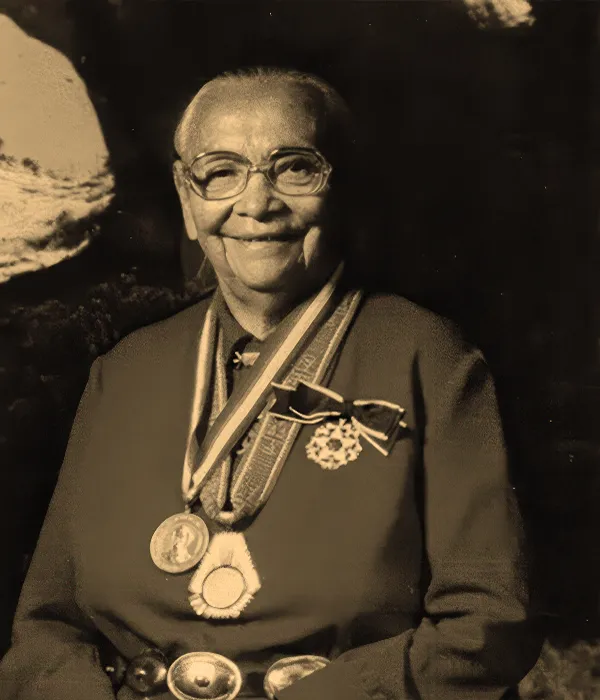

Annie Dodge Wauneka (1910–1997) was a towering figure in the history of the Navajo Nation and a key player in the broader context of Sedona, Arizona’s cultural and historical landscape. Born on April 11, 1910, in a hogan near Sawmill, Arizona, on the Navajo Reservation, she was the daughter of Henry Chee Dodge, a prominent Navajo leader and the first chairman of the Navajo Tribal Council, and Kee’hanabah (Mary Shirley Begaye). Raised in a family that bridged Navajo traditions and Anglo influences, Annie’s early life was shaped by both her father’s political prominence and the stark realities of reservation life, including poverty and disease. Her connection to Sedona emerges through her broader impact on Northern Arizona and her legacy as a regional icon, celebrated in places like the Sedona Heritage Museum’s productions.
Annie’s path to prominence began with her education, a rarity for Navajo girls at the time. At age eight, she was sent to a government boarding school in Fort Defiance, Arizona, where she survived the 1918 Spanish influenza epidemic that claimed many of her classmates. This experience, coupled with her recovery from a mild case that allowed her to assist the sick, ignited a lifelong passion for public health.
She later attended the Albuquerque Indian School, where she met George Wauneka, whom she married in 1929 against tribal norms of arranged marriages. Together, they raised a large family—eventually having ten children, though two died young—while George supported Annie’s ambitions by managing their home and sheep herds in Klagetoh, near Window Rock.
Her political career took off in 1951 when she was elected to the Navajo Tribal Council, becoming the second woman to serve in that body after Lily J. Neil. Representing the Klagetoh and Wide Ruins chapters, Annie held her seat for 27 years, often as the sole woman among male councilors. Appointed head of the Health and Welfare Committee, she tackled the rampant tuberculosis crisis devastating Navajo communities in the 1950s. Drawing from her boarding school experiences and travels with her father, she understood the cultural barriers to Western medicine. She earned a Bachelor’s degree in Public Health from the University of Arizona in the mid-1950s and used her knowledge to bridge these gaps, creating an English-Navajo medical dictionary to demystify terms for her people and collaborating with traditional healers (hataałii) to integrate modern and Navajo practices.
Annie’s efforts extended beyond tuberculosis. She launched campaigns to reduce infant mortality—achieving a 25% drop in the 1960s—by encouraging hospital births and distributing clothing and blankets as incentives. She addressed alcoholism, trachoma, and influenza, while advocating for sanitation improvements like wooden floors, better water quality, and modern plumbing in Navajo homes. Her tireless work involved crisscrossing the vast reservation in a battered station wagon or pickup truck, delivering supplies, educating families, and broadcasting health advice in Navajo via weekly radio programs. Her influence reached national levels, serving on advisory boards for the U.S. Surgeon General and the Public Health Service, and shaping federal Indian health policy.
Though not a Sedona resident, Annie’s legacy resonates in the region’s history. Sedona, just south of the Navajo Nation’s boundaries, became a stage for celebrating her contributions through cultural events like The Dead Quilters Society, a musical dramedy premiered in 2024 at the Sedona Heritage Museum. The production, featuring Annie alongside other Sedona luminaries like Marguerite Staude and Katie Lee, underscores her role in weaving the area’s cultural fabric. Her work improved lives across Northern Arizona, indirectly supporting Sedona’s evolution as a hub for diverse communities and visitors drawn to its natural and historical richness.
Annie’s accolades reflect her impact: in 1963, she became the first Native American to receive the Presidential Medal of Freedom, awarded by President Lyndon B. Johnson for her health advocacy. She earned honorary doctorates from the University of Arizona (1976, 1996) and the Navajo Medal of Honor in 1984, when the Navajo Nation Council dubbed her “Our Legendary Mother.” Diagnosed with Alzheimer’s in 1993, she continued advising the council into her 80s, passing away on November 10, 1997, in Flagstaff. Posthumously inducted into the National Women’s Hall of Fame in 2000, Annie Dodge Wauneka remains a symbol of resilience, leadership, and the power of education and compassion to transform a nation—her influence echoing from the Navajo heartland to the red rocks of Sedona.